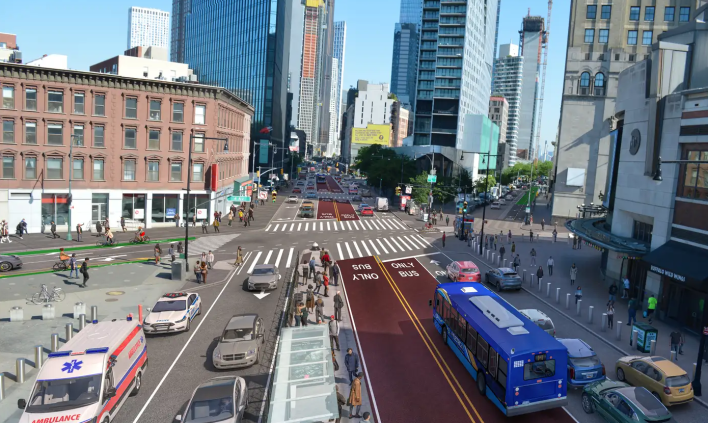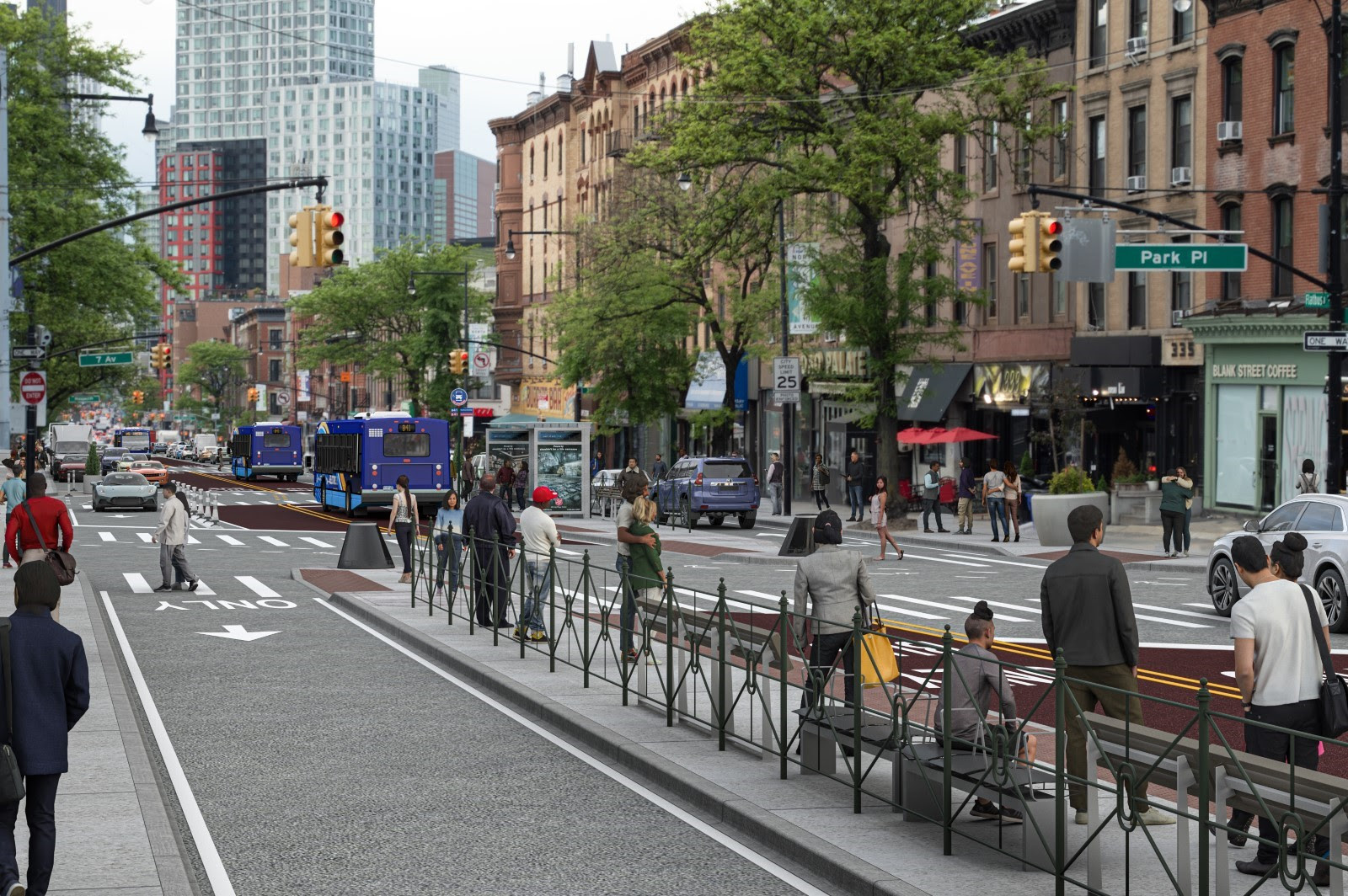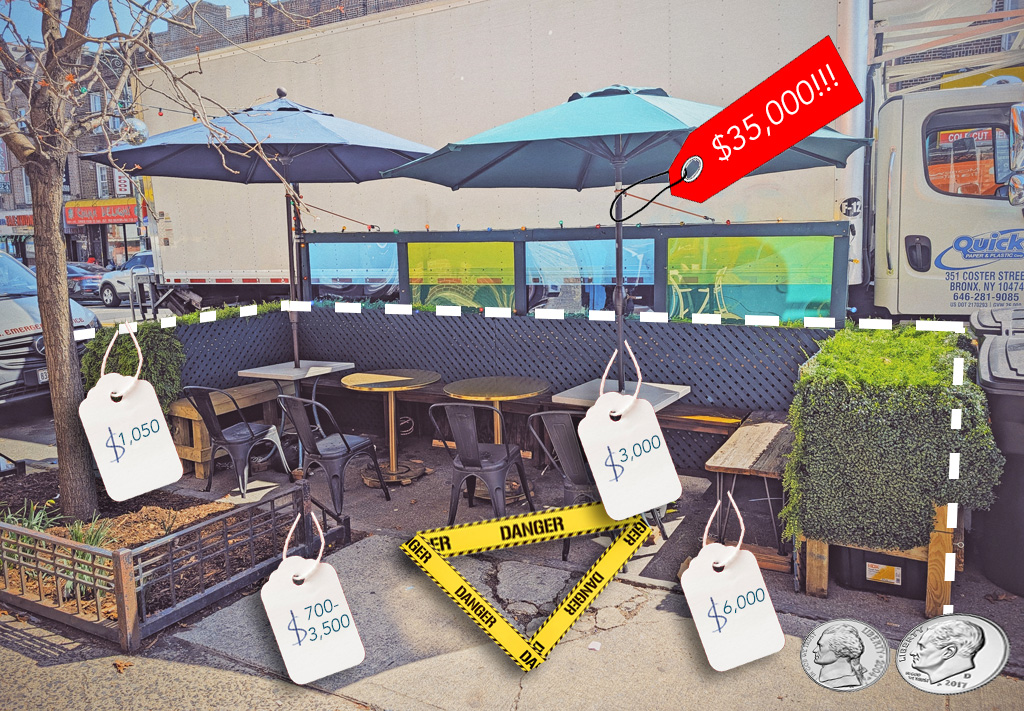A proposed center-running bus lane on Flatbush from Grand Army Plaza to Livingston Street is an opportunity to create the kind of transit-way rarely seen in New York City — if everything's done right.
On Thursday night, Department of Transportation officials told the plan to the Transportation Committee of Brooklyn Community 2: center-running bus lanes through the congestion one-mile sluice, plus concrete bus boarding islands outside Atlantic Terminal and the subway stations at Park Place (2/3) and Seventh Ave. (B/Q).
And officials hope to install it this year.
The goal is to make Flatbush Avenue "a high performing transit priority street that connects various Brooklyn neighborhoods" — rather than a road that merely moves cars between Brooklyn and Manhattan, DOT Assistant Director of Bus Priority Dustin Khuu said at the meeting.
With a center-running bus lane and strategically placed bus boarding islands along the corridor, officials will calm traffic, create shorter crossing distances for pedestrians and improve bus service. The bus island mimic a design the city used on Edward L. Grant Highway in the Bronx back in 2020.
But crucial details are still missing from the plan — most important how officials will keep cars and trucks out of the red paint. DOT renderings showed that curbside parking would remain on some parts of the corridor where drivers only have one lane for travel. That could defeat the purpose of the bus lane if double-parked vehicles force traffic into the lane.
Another rendering, though, does show what a bus boarding island further south, at Flatbush and Park Place could look like: In the image (at the top of this story), curbside parking is nowhere to be seen on either side Flatbush. Instead, the curbside lane is a general travel lane hemmed in by the curb and a bus boarding island next to the center bus lane.
Reducing parts of Flatbush to one car travel lane and giving pedestrians more refuge as they cross the street is the type of treatment that could change the fabric of the area around Flatbush Avenue in major ways.

"As someone who grew up in Park Slope, that's revolutionary," said Riders Alliance Director of Policy and Communication Danny Pearlstein. "It will help tie together two neighborhoods separated by Flatbush Avenue by making the street more livable at a human scale. It's a glorious vision."
DOT didn't share a block-by-block breakdown with the community board, but officials said after the meeting that there's a possibility the bus lane will be physically protected. Khuu and other DOT officials at the meeting said the agency would return with a more detailed plan in the fall, possibly as early as September, and that the city is aiming to complete the project in 2025.
If the center-running bus lane goes in as planned, though, it will create huge amounts of space for multiple buses that use Flatbush Avenue, created a red-painted runway for the B41 between Grand Army Plaza and Livingston Street, which already has a busway.
That will allow for smooth riding on a bus that serves 28,000 trips per day but often gets stuck in grinding Downtown Brooklyn traffic. Bus speeds on the B41 on northern piece of Flatbush Avenue get as low as 4 miles per hour during evening and morning rush hours, and don't improve much anywhere between Livingston and Grand Army.
Right now — months after congestion pricing launched — is as good a time as any to rejigger the uses of Flatbush Avenue, DOT said.
During the presentation, Khuu noted that the percentage of northbound car trips on Flatbush Avenue in Downtown Brooklyn that were headed to Manhattan had dropped from 44 percent to 33 percent since congestion pricing began. Only 7 percent of those trips wound up in lower Manhattan, which Khuu said meant that the vast majority of drivers aren't heading to the Brooklyn or Manhattan bridges anyway.
Traffic patterns will change as a result of center-running bus lanes and car traffic will disperse to other streets, but Khuu also said that the DOT expect some drivers will actually switch to bus service once it become more reliable. Some trips to and from Manhattan would switch to transit, Khuu said.
Redesign elements like bus-level boarding islands and bus lanes can give the bus the same kind of sheen that subway travel has, Pearlstein said.
"Center-running bus lanes transform their corridors," he said. "Curbside bus lanes sneak in and shoehorn bus priority on busy streets, but center running lanes dignify riders and demonstrate how important transit is on our streets, not just underground."
The proposed design would also fit existing conditions on Flatbush, which ban left turns onto cross streets between Grand Army Plaza and Livingston Street already, so the roadway is mostly a through street.
DOT officials said the transit-first design to the street will discourage drivers from using Downtown Brooklyn as a cut-through neighborhood.
"I think the huge advantage of the design right is that we are deprioritizing that through traffic like the neighborhood is no longer a place where people drive through to get to other places," said DOT Bus Priority Program Director Nolan Levenson.
The DOT also wants to add a sweetener to businesses; Khuu told the community board that the agency is studying where to put truck loading zones on side street spurs. Where the design retains parking, meters will be retimed for short-term parking to encourage churn and discourage people from trying to park there all day, Khuu said.
A little history
Such a major overhaul to a large street is possibly more challenging politically than it is in terms of traffic engineering.
The Flatbush Avenue project has run into its share of challenges under Mayor Adams. The concept sat in stasis for over a year after DOT began outreach — reportedly due to interference inside City Hall from anti-transit advisers and bureaucrats pushing their weight around.
The consequences of that aspect of Adams's mayoralty were inadvertently on display Thursday night, as the original rendering of the bus lane showed a fully-completed protected bike lane on Ashland Place. Famously, the mayor chopped that piece of the bike lane off of the project after objections from politically-connected real estate developer Two Trees. By the time the press release went out on Friday, the offending bike lane rendering had been removed:
In its official press release this morning, DOT removed the two-way bike lane on Ashland Place from its Flatbush redesign rendering that eagle-eyed folks had spotted in a Wednesday version of the graphic.
— Kevin Duggan (@kevinduggan.bsky.social) 2025-06-06T14:28:06.596Z
The unpredictable nature of the Adams transit and street safety agenda hardly makes this a slam dunk. Advocates have done what they can to shore up support for the project and keep it from getting watered down or not done at all like what happened on the Bronx's Fordham Road, where when the mayor killed plans for a busway and then a compromise offset bus lane.
Unions and non-transit advocacy organizations have joined the push for the bus lane. Council Members Lincoln Restler, Shahana Hanif, Crystal Hudson and Rita Joseph, who represent Flatbush Avenue from the bridges to Clarendon Road, sent a letter asking for a center-running bus lane. All eyes now turn to City Hall to see if the plan actually happens.
"DOT has taken this as far as they can, and now it's up to the mayor to bring better buses to Flatbush Avenue," said Pearlstein.






